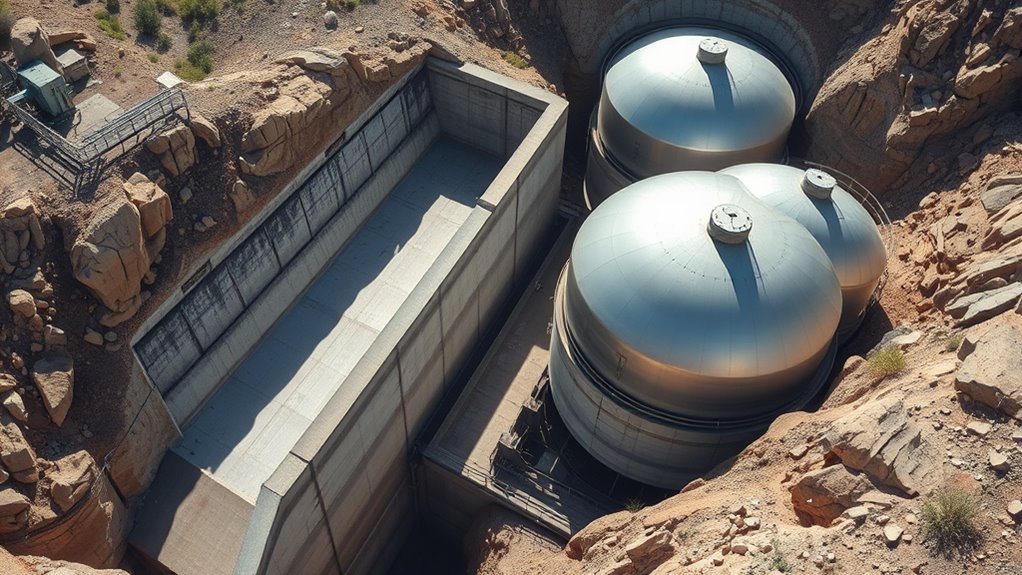Troughs and surge tanks need extra volume to absorb sudden pressure changes caused by valve closures or pump shutdowns, preventing damaging water hammer effects. This extra capacity acts as a buffer, smoothing out flow variations and protecting pipes and equipment from stress and shock. Without sufficient volume, your system risks damage, failures, and instability. Continue exploring to understand how proper sizing guarantees reliable, safe water distribution and system longevity.
Key Takeaways
- Extra volume in troughs and surge tanks buffers pressure surges, preventing pipe damage caused by sudden flow changes.
- They absorb excess water during peak flows, reducing system stress and preventing overflows or pressure spikes.
- Additional capacity dampens water hammer effects, protecting pipes and fittings from high-pressure shocks.
- Proper sizing of extra volume ensures stability during demand fluctuations and unexpected flow surges.
- Well-designed extra volume features extend equipment lifespan and improve overall system reliability.
The Role of Troughs and Surge Tanks in Water Systems
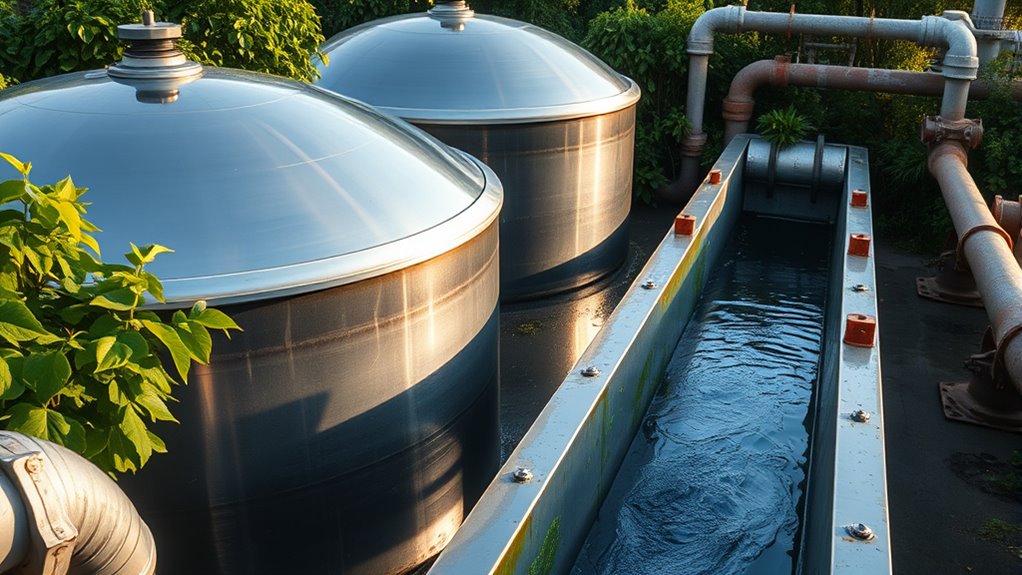
Troughs and surge tanks play a crucial role in maintaining stability within water systems. They act as buffer zones, absorbing sudden changes in water flow and pressure. When demand spikes or pumps turn on and off, these tanks help prevent pressure fluctuations that could damage pipes or disrupt service. Surge tanks, often positioned at high points, store excess water and release it gradually, reducing stress on the system. Troughs, on the other hand, serve as reservoirs that ensure consistent water levels and flow rates. By providing extra volume, these features smooth out variations and support system reliability. Extra volume helps absorb pressure surges and maintain steady operation. Without them, water systems would be vulnerable to pressure surges, leaks, and breakdowns, making these components indispensable for efficient and safe operation.
Understanding Pressure Surges and Water Hammer
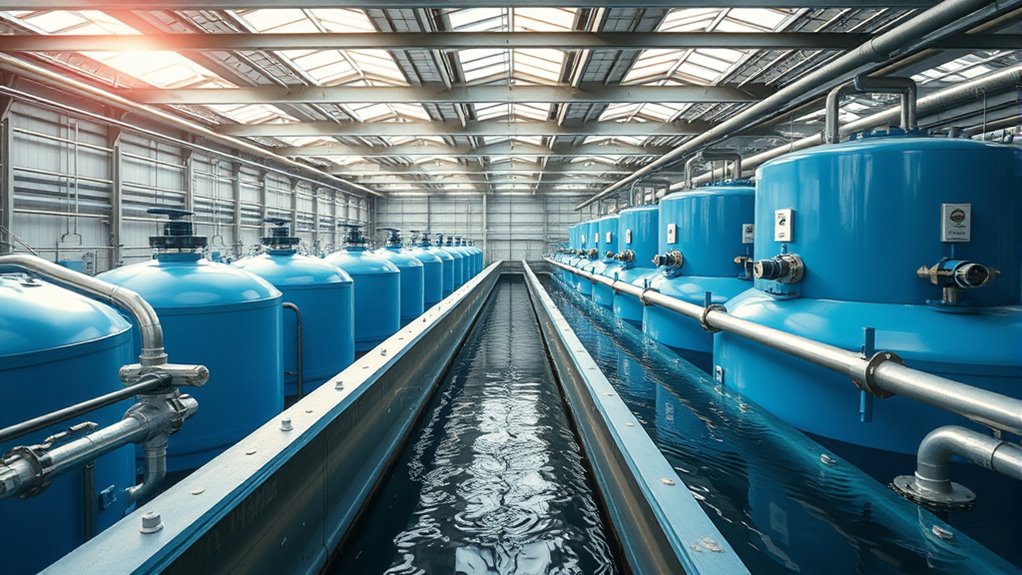
Understanding pressure surges and water hammer is essential for maintaining the safety and integrity of water systems. When valves close suddenly or pumps switch off abruptly, the rapid change in flow causes a pressure spike, known as a water hammer. This sudden surge can create high-pressure waves that travel through pipes, risking damage or failure. Water hammer occurs because water is nearly incompressible, so it resists abrupt changes in velocity. You might notice banging noises, vibration, or even pipe bursts if these surges aren’t controlled. To prevent this, engineers design systems with features like surge tanks or air chambers, which absorb or cushion the pressure fluctuations. Recognizing the causes and effects of water hammer helps you implement better safeguards, ensuring your system remains safe and durable. Additionally, incorporating extra volume like troughs and surge tanks can effectively reduce the impact of pressure surges and protect the plumbing system.
How Excess Volume Absorbs Pressure Fluctuations

When excess volume is present in a system, it helps dampen sudden pressure spikes. This prevents damage to pipes and equipment, ensuring the system stays safe. Additionally, it maintains steady flow, reducing the risk of disruptions. Properly designed surge tanks and troughs utilize this excess volume to effectively absorb pressure fluctuations preventing system failures.
Dampens Pressure Spikes
Excess volume in surge tanks acts as a buffer that dampens pressure spikes in a piping system. When flow suddenly changes—like a pump startup or shutdown—the extra volume allows the system to absorb these rapid shifts without causing dangerous pressure surges. As pressure rises quickly, the surge tank’s volume accommodates the increased fluid, reducing the immediate impact on the pipes and valves. This absorption prevents sudden jolts that could damage equipment or cause system instability. By providing this cushion, the surge tank ensures smoother operation during transient events. You benefit by avoiding abrupt pressure increases that could lead to leaks or failures. Basically, the excess volume acts like a shock absorber, making pressure fluctuations less severe and maintaining system stability. Additionally, implementing suspension upgrades can improve overall handling and stability during these pressure variations.
Prevents System Damage
The extra volume in surge tanks plays a vital role in preventing damage to your system by absorbing pressure fluctuations before they reach sensitive components. When fluid flow changes suddenly, pressure can spike and cause stress on pipes, valves, and pumps. The additional volume acts as a buffer, accommodating these abrupt shifts and reducing the risk of bursts or leaks. By dampening rapid pressure increases, surge tanks help maintain steady operating conditions, protecting your equipment from excessive wear and possible failure. This buffer effect minimizes the mechanical strain on system parts, extending their lifespan. Overall, having extra volume in surge tanks guarantees your system remains safe, reliable, and less prone to costly damage caused by pressure surges. Additionally, incorporating proper system design ensures your surge tanks function effectively within your overall water management setup.
Maintains Flow Stability
How does extra volume in surge tanks help maintain flow stability? When flow rates fluctuate suddenly, excess volume acts as a buffer, absorbing pressure spikes and drops. This prevents rapid changes from reaching downstream equipment, which could cause vibrations, cavitation, or damage. The additional volume provides a space where water can expand or contract smoothly, reducing turbulence and maintaining a steady flow. As pressure increases, the surge tank temporarily holds excess water, releasing it gradually as pressure drops. This balancing act keeps flow rates consistent, ensuring system stability. Without this extra volume, pressure fluctuations would transfer directly through the system, risking operational interruptions and damage. In short, the extra volume helps you maintain a reliable, stable flow, even amid sudden demand or pressure changes. Incorporating protective features like surge tanks enhances overall system durability and performance.
The Impact of Insufficient Capacity on System Stability
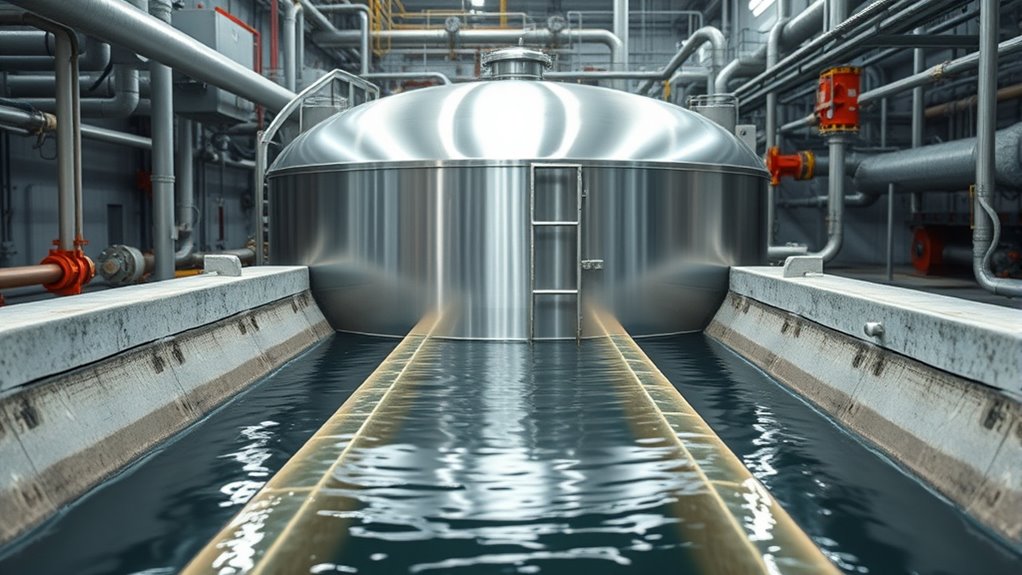
When a surge tank or troughs lack sufficient capacity, the entire system becomes vulnerable to instability. Without enough volume to absorb pressure changes, sudden flow variations can cause dangerous fluctuations. These fluctuations lead to pressure surges and drops that strain pipes, valves, and pumps. If the tank can’t handle peak flows, it forces the system to compensate elsewhere, increasing wear and risking failures. Inadequate capacity also reduces the system’s ability to dampen transient effects, making it prone to oscillations and instability. Over time, these issues can cause leaks, equipment damage, or shutdowns. Proper sizing ensures stability, preventing costly disruptions and extending system lifespan. Additionally, understanding system dynamics helps in designing tanks with appropriate capacity to maintain reliable operation.
Design Principles for Proper Sizing of Storage Features
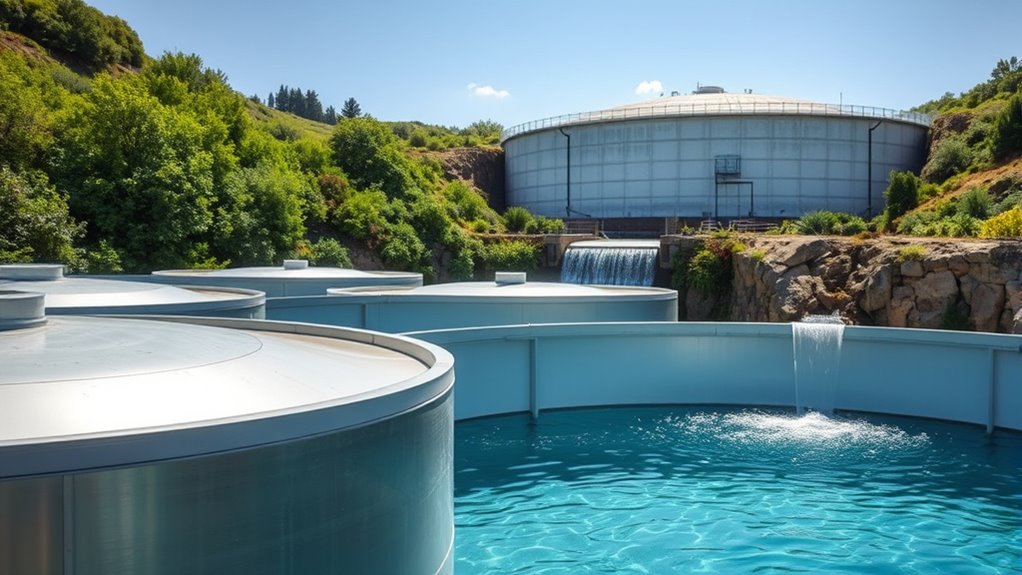
Proper sizing of storage features like troughs and surge tanks is key to maintaining system stability and preventing operational issues. To do this effectively, you should analyze the flow rates and fluctuations within your system, ensuring the storage volume can accommodate peak surges without overflow or pressure drops. Consider the maximum expected flow variations and design your tanks to handle these comfortably. Additionally, account for system transient behaviors—such as startup or shutdown phases—that require extra buffer volume. You should also select sizing based on operational flexibility, allowing for maintenance and unexpected demand spikes. Always balance volume with space and cost constraints, and verify your calculations through simulations or pilot testing. Properly sized storage features help sustain steady operation and protect your system against instability. Incorporating clutter-free organization principles can also make maintenance and adjustments more manageable over time.
Case Studies Highlighting the Importance of Extra Volume
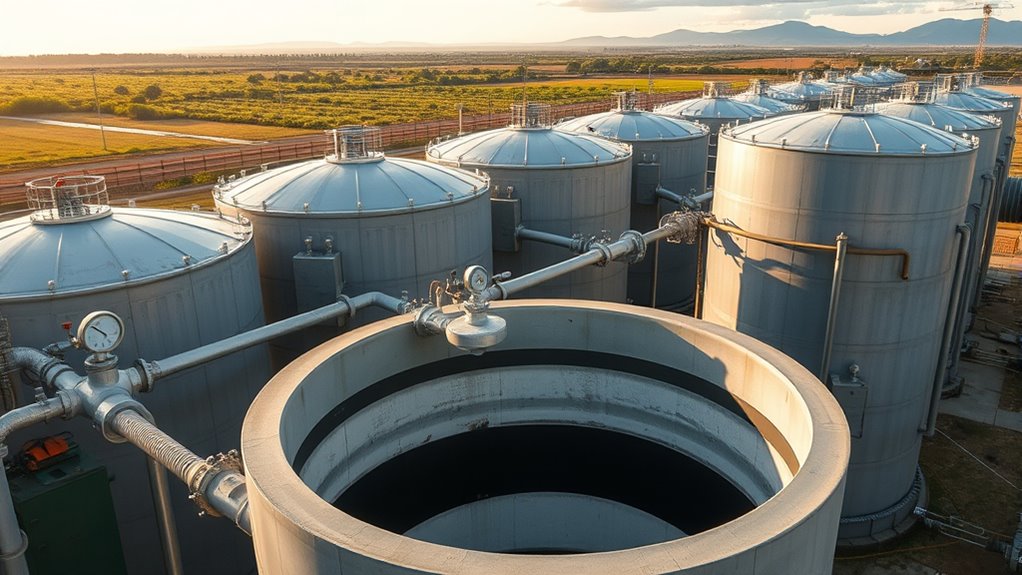
Examining real-world cases shows how extra volume in troughs and surge tanks helps manage peak flow rates effectively. You’ll see how it prevents system overflows and keeps operations stable during sudden surges. These examples highlight why designing for additional capacity is essential for reliable performance. Incorporating adequate capacity can also accommodate unexpected fluctuations, ensuring the system remains resilient under varying conditions.
Managing Peak Flow Rates
Have you ever considered how sudden surges in flow rates can overwhelm a drainage system? When large volumes enter quickly, your system needs extra capacity to handle the load without failure. Surge tanks and troughs are designed precisely for this purpose—they absorb unexpected peaks, preventing backups and damage. For example, in flood-prone areas, adding extra volume buffers has successfully mitigated risks during storms. These features act as temporary reservoirs, controlling flow velocities and reducing pressure on downstream components. Without adequate volume, the system struggles to cope with rapid inflows, increasing the chance of overflows and structural stress. Properly managing peak flow rates with extra volume ensures your drainage system remains resilient, even during intense or unpredictable flow events. Additionally, understanding system sizing is crucial to ensure these features function effectively under varying conditions.
Preventing System Overflows
Case studies clearly demonstrate that without extra volume buffers like surge tanks and troughs, drainage systems are prone to overflows during heavy or unpredictable flows. In one example, a municipal sewer system experienced frequent overflows during storm events because it lacked adequate buffering capacity. When heavy rain hit, water quickly exceeded the system’s capacity, spilling onto streets and causing backups. Installing surge tanks and troughs created additional storage space, absorbing sudden flow increases and preventing overflows. These buffers slow down rapid inflows and hold excess water temporarily, giving downstream systems time to process it safely. By providing this extra volume, you reduce the risk of system failure, protect infrastructure, and minimize environmental and property damage during peak flow conditions.
Ensuring Operational Stability
Ensuring operational stability in drainage systems depends heavily on the strategic use of extra volume buffers like surge tanks and troughs. These features absorb sudden flow changes, preventing system stress and failures. Case studies show that facilities with well-designed buffers experience fewer shutdowns and damage during peak flows. For example:
| Situation | Buffer Effect | Result |
|---|---|---|
| Heavy rainstorms | Dampens flow spikes | Maintains system stability |
| Pump failures | Provides backup volume | Prevents overflow |
| Sudden inflow | Absorbs transient surges | Reduces pressure spikes |
| System start-up | Ensures smooth flow transition | Avoids system shocks |
Using extra volume strategically keeps your drainage system resilient and operational under variable conditions.
Common Mistakes in Sizing Troughs and Surge Tanks
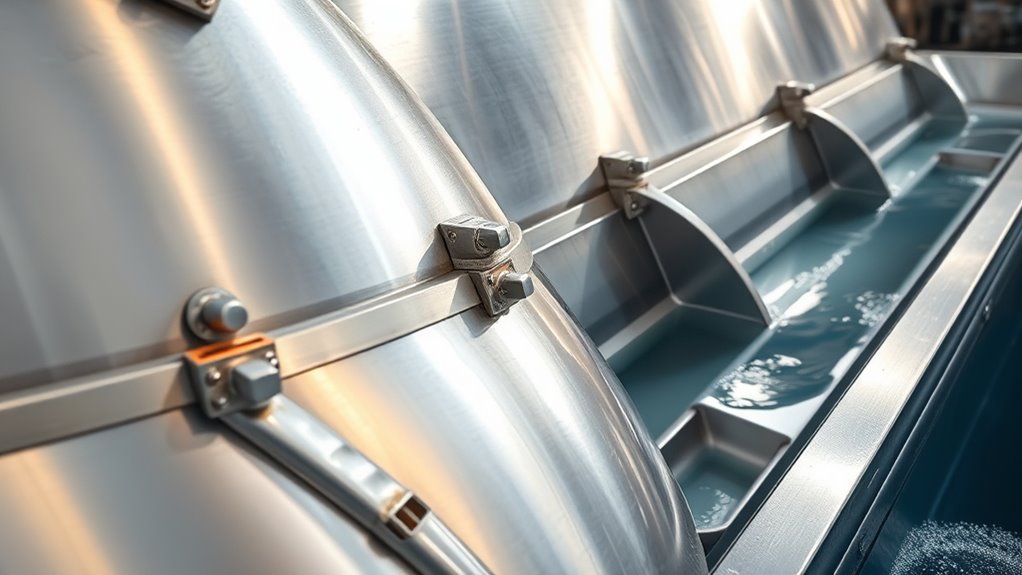
One of the most common mistakes when sizing troughs and surge tanks is underestimating the flow fluctuations they need to accommodate. If you don’t account for peak variations, your system might not handle sudden surges or drops, leading to pressure issues or equipment stress. Many overlook the importance of analyzing historical flow data thoroughly, resulting in tanks that are too small for real-world conditions. Additionally, choosing sizes based solely on average flow rates can be misleading. You need to consider the maximum expected flow and the potential rate of change. Failing to incorporate these fluctuations can cause operational inefficiencies, increased wear, or even system failures. Proper sizing requires a detailed understanding of flow variability, ensuring your troughs and surge tanks provide reliable volume during all operational scenarios.
Best Practices for Ensuring Reliable Water Distribution
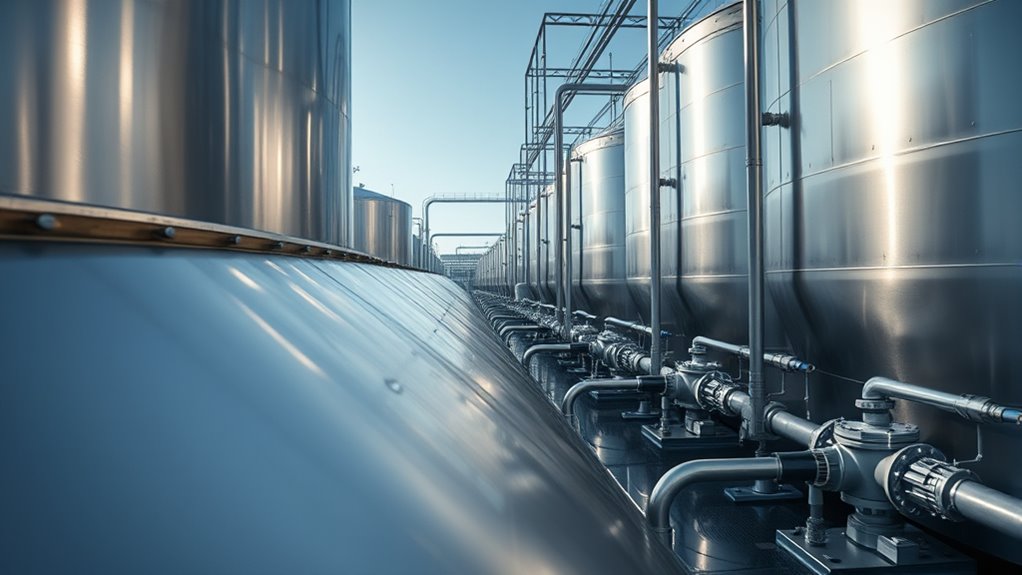
To maintain reliable water distribution, it’s essential to follow best practices that manage flow variability and strengthen system resilience. Proper design and operation ensure consistent supply and prevent failures. Keep these practices in mind:
Maintaining reliable water distribution requires best practices to manage flow and enhance system resilience.
- Regularly calibrate control valves to optimize flow regulation
- Install surge tanks or expansion chambers at strategic points
- Use pressure relief valves to prevent system overloads
- Monitor flow and pressure data continuously for early detection
- Design for redundancy, allowing alternative pathways in case of failure
Implementing these strategies helps you maintain system stability, reduce downtime, and ensure water reaches its destination efficiently. Staying proactive and attentive to system performance is key to reliable, long-term water distribution.
Frequently Asked Questions
How Do Environmental Factors Influence the Sizing of Troughs and Surge Tanks?
Environmental factors like temperature fluctuations, humidity, and seasonal rainfall profoundly influence the sizing of troughs and surge tanks. You need larger capacities if you face high variability in water demand or unpredictable weather patterns. Extreme temperatures can cause expansion or contraction, so extra volume helps accommodate these changes. By considering local climate conditions, you guarantee your system maintains proper flow and prevents overflow or shortages during environmental extremes.
What Materials Are Best Suited for Constructing Extra-Volume Storage Features?
You should select sturdy, corrosion-resistant materials like stainless steel, reinforced plastics, or fibreglass for constructing extra-volume storage features. These materials withstand harsh environmental elements, resist rust, and guarantee longevity. By choosing tough, tested materials, you’ll create reliable, resilient reservoirs that resist wear and weather. This ensures your storage features not only handle volume demands but also endure environmental challenges, providing peace of mind and dependable performance over time.
How Often Should Surge Tanks Be Inspected for Capacity Adequacy?
You should inspect surge tanks at least quarterly to guarantee capacity remains adequate. Regular inspections help identify sediment buildup, corrosion, or any signs of wear that could reduce volume. Additionally, after major system changes or extreme weather events, more frequent checks are advisable. By staying proactive with your inspections, you ensure the surge tanks function properly, preventing potential system failures or flooding caused by insufficient capacity.
Can Existing Water Systems Be Retrofitted With Appropriately Sized Storage Features?
Yes, you can retrofit existing water systems with appropriately sized storage features. Start by evaluating your current capacity and identifying areas where additional volume is needed. Work with a professional to select suitable tanks or troughs that fit your system’s space and flow requirements. Installing these features ensures better pressure regulation and reduces system stress, ultimately improving reliability and efficiency. Retrofitting is a practical solution to enhance your system’s performance without replacing everything.
What Are the Cost Implications of Installing Larger Troughs and Surge Tanks?
Installing larger troughs and surge tanks is like adding a bigger reservoir to a city’s water supply—your costs increase with size. You’ll face higher material expenses, more complex installation, and potentially increased maintenance. While the upfront investment is steeper, it guarantees better system stability, especially during peak demand or disruptions. Consider these long-term benefits against the initial costs to determine if the extra volume’s worth the investment.
Conclusion
Think of troughs and surge tanks as the safety valves of your water system’s heartbeat. When you give them just enough room, they can dance gracefully through pressure surges, keeping everything steady. But if you skimp on their size, it’s like trying to hold back a storm with a bucket—soon, chaos ensues. So, size them right, and let your system breathe easy, resilient as a mighty river flowing smoothly through any challenge.
